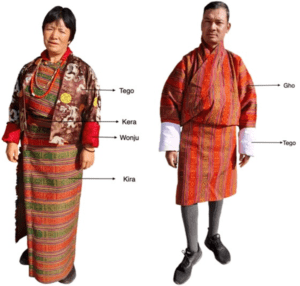ABOUT BHUTAN
| Area | 38,394 sq. km. |
| Population | 777,486 |
| Capital | Thimphu |
| Local time | GMT+6 |
| Religion | Mahayana Buddhism |
| National tree | Cypress |
| National flower | Blue poppy |
| National animal | Takin |
| National bird | Raven |
| National sport | Archery |
| National day | 17 December |
| National language | Dzongkha |
| Currency | Bhutan’s Ngultrum (Nu) |
The Kingdom of Bhutan is a landlocked country in the Eastern Himalayas. It is bordered by China to the north and India to the south. Nepal and Bangladesh are located in proximity to Bhutan but do not share a land border. In the Bhutanese Himalayas, there are peaks higher than 7,000 meters (23,000 ft) above sea level. Gangkhar Puensum is Bhutan’s highest peak and may also be the highest unclimbed mountain in the world.
A visit to Bhutan is like taking a step back in time – it’s a land where traditional values and an old way of life are still practiced and, where visitors can get a rare glimpse into another world. While Bhutan is best known for its stunning mountain scenery with a strong emphasis on environmental conservation, there is so much more to this country than meets the eye. Bhutan has a rich history dating back centuries, and its people have a deep cultural heritage that is evident in everything from their crafts and architecture to their music and dance.
About Bhutan Culture: Bhutan’s culture is rich and unique, it is a land of stunning natural beauty, with snow-capped mountains, pristine rivers, and verdant valleys with main attractions such as its stunning natural scenery, its unique architecture, and its vibrant festivals.
Our country has something to offer everyone, from beginners to experienced hikers. There are also plenty of cultural attractions to enjoy, such as temples and monasteries.
About Bhutan National Emblem
The National Emblem of Bhutan is a circle that projects a double diamond thunderbolt placed above the lotus. There is a jewel on all sides with two dragons on the vertical sides. The thunderbolts represent the harmony between secular and religious power while the lotus symbolizes purity.The jewel signifies the sovereign power while the two dragons(male and female) represent the name of the country DrukYul or the Land of the Dragon.
There is a jewel on all sides with two dragons on the vertical sides. The thunderbolts represent the harmony between secular and religious power while the lotus symbolizes purity.The jewel signifies the sovereign power while the two dragons(male and female) represent the name of the country DrukYul or the Land of the Dragon.
National Dress of Bhutan
 About Bhutan National Dress – The history of Bhutan’s tradition and culture closely follow the history of Buddhism. Guru Padmasambhava, who brought Buddhism to Bhutan, thus remains the single most important and influential. Bhutan’s national attire is known as gho for men and kira for women. Zhabdrung Ngawang Namgyel introduced it in the 17th century to give Bhutanese a distinct identity.
About Bhutan National Dress – The history of Bhutan’s tradition and culture closely follow the history of Buddhism. Guru Padmasambhava, who brought Buddhism to Bhutan, thus remains the single most important and influential. Bhutan’s national attire is known as gho for men and kira for women. Zhabdrung Ngawang Namgyel introduced it in the 17th century to give Bhutanese a distinct identity.
The gho worn by men is a knee length wraparound skirt, which is tied at the waist by a belt. The pouch that forms on the chest is used as a pocket to carry valuable items. Westerners have often remarked on Bhutan’s distinctive traditional dress as having the biggest pocket in the world. A white, small cylindrical piece of cloth called the lagey is attached to the sleeve and folded inside out. In ancient times and even today, people carry daggers that are fastened on the belt along their hips. Officials with rank and power are bestowed a long sword called the patang. This sword, which can be used both as a tool and a weapon is symbolic of men defending the country as well as building it. Both Bhutanese men and women wear a scarf during important occasions and when entering a dzong or a monastery. As a symbol of respect, the scarf is lowered in front of those with higher position including the king. Ordinary Bhutanese wear white scarves while those of a higher rank that wear red are referred to as Dashos. Parliamentarians wear blue and the king wears the yellow scarf.
A woman’s equivalent of the scarf is called the Rachu. Rachus worn by ordinary women are hung over the shoulder and is woven in colorful embroidery. All men and women including the civil servants wear their traditional dress during office hours.
About Bhutan National Flag
 The National flag is divided diagonally into two equal halves.
The National flag is divided diagonally into two equal halves.
The upper yellow half signifies the secular power and authority of the king while the lower saffron-orange symbolizes the practice of religion and the power of Buddhism, manifested in the tradition of Drukpa Kagyu. The dragon signifies the name and the purity of the country while the jewels in its claws stand for the wealth and perfection of the country.
